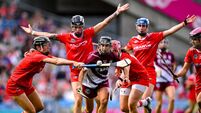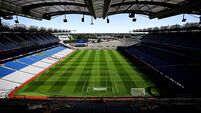Jimmy’s smiling now as grey days over for Dubs
But, as county board chairman, he was instrumental in Kevin Heffernan’s appointment as football manager which not only revived their fortunes but breathed new life into the GAA nationally.
So, as a recognised stakeholder in the development of Gaelic games in the capital, Jimmy Gray takes immense pride in the progress of all of their county teams this year.
Interestingly, while most people associate him with his goalkeeper role in the (0-16 to 1-12) loss to Tipperary in the 1961 hurling decider, his initial involvement was with the Dublin senior footballers as a panellist from 1954-56 seasons.
In 1955, Dublin went into the All-Ireland final as firm favourites but were shocked by a Kerry team captained by the legendary John Dowling.
“That was a sad day,’’ he remarked.
Dropped from the squad two years later, he quickly joined the senior hurling panel. He was first introduced as a sub for a Walsh Cup final against Kilkenny in Nowlan Park and continued on until 1966. Dublin contested the 1954 Leinster final — losing heavily to Wexford — and he was firmly established in the team when they made their next appearance, in 1959, when they lost by a point to Kilkenny.
“We were winning by two points with five minutes injury time played and Sean Clohessy scored a goal from nowhere,” he recalled.
Losing the All-Ireland final two years later was a more bitter pill to swallow.
“Tipperary got a point that was a yard wide and so they equalised when we were a point ahead. That stuck in the craw for a long time,
” His experience of the interprovincial series was from the vantage point of the sideline, with Ollie Walsh reigning supreme around that time.
“Ollie was a great goalkeeper and a very nice chap as well. He was always there and I was sub goalkeeper. We won the Railway Cup in 1962 and the same year the Rest of Ireland played Tipperary in Thurles. Christy Ring was the captain of the Rest’ team and he was telling everybody that we’d have to beat Tipperary. He came over to me and said, ‘you know you shouldn’t be playing here, Ollie Walsh should be playing. You’d better not let anything in’.”
Agreeing that insufficient work was put in to capitalise on the 1961 campaign, even though they captured the 1965 minor title, he added: “There wasn’t the same commitment or foot-work put into hurling that there has been in the last 15 years. An awful lot of hurling was kind of taken for granted at the time.”
Ironically, the success of the senior footballers in the mid-’70s was to aid the revival of the game in terms of establishing clubs on a much sounder footing.
“Prior to Kevin Heffernan’s appointment, football was not very healthy and the GAA was going through a bad time after the 1966 World Cup in England. There’s no doubt that Dublin and Kerry rescued the GAA.
“They gave it a huge boost. Certainly in Dublin. Back then you could have 500 people at a county final.”
While he had no interest in becoming involved in administration, he was persuaded to stand for election by former Dublin and Leinster chairman Tom Loftus. In the end, he served as chairman for ten years and went on to become Leinster chairman for a three-year term. He was also nominated for the presidency on five occasions, standing in 1978.
Heffo too had been reluctant to get involved because he was so committed to St Vincent’s, but he was persuaded to change his mind. “He was a good friend of mine and I knew his attitude to the game,” he explained.
“He was very original and innovative from the point of view of his approach.”
The view might be taken that the success of the team in winning three All-Irelands — 1974, ‘76 and ‘77 with the younger Kerry side dominant from 1978 onwards — pushed hurling into the background but he insists a lot of effort was put into its promotion at official level. It was more a problem of the prevailing club structure.
“To a large extent, it didn’t lend itself to the promotion of hurling. What arose out of the ‘70s football team was new clubs, highly organised based in ‘areas’ of the county. The strength of the GAA was the parish and the strengths of the GAA in Dublin now are the clubs. And that’s because in a place like Dublin they do represent the centre of the community.
“Clubs like Ballyboden deserve great credit for the way they developed hurling, specialising it at one time. The whole thing stemmed from there and it took that amount of time to get the stream going — to have the players coming through. On top of that the GAA did invest a lot of money in coaching and the evolution of that is that hurling in Dublin now is very strong.
“It has gone from a stage where the approach to the game was kind of lackadaisical to the clubs being highly organised. Back in the ‘70s, (exclusive) senior hurling clubs had not been heard of.”
He had a spell as Dublin hurling manager himself, from 1993 to 96. While resources were fairly limited, in his second year they took Wexford to a replay in the semi-final. And, two years later Wexford were All-Ireland champions.
In turn, he was replaced by Michael O’Grady, a man with an impressive CV, who managed his native Limerick, Tipperary and Wexford before settling in Dublin.
“Michael has been a marvellous contributor to hurling in Dublin and still is as chairman of the Friends of Dublin hurling,” he commented.
Nevertheless, while a lot of others played a major role on the coaching side, he ascribes much of the progress made on the hurling front in recent years to the clubs themselves.
“Considering the huge effort made at ground level, understandably it has been important to see a return,” he said. “Three Dublin teams in the All-Ireland semi-final in hurling — that is a remarkable result of the work done already. But, I think it may be premature to expect too much at the present time!”














